Working with private industry, the University of Cambridge has gone one step beyond 3D printing with a concrete infrastructure unit that was not only made in an hour, but incorporates sensors to make it self-monitoring and, one day, self repairing.
If there's one topic least likely to spark animated dinner party conversation, it's the bits and pieces of civil engineering that one sees while driving along a nation's road networks. These tend to be taken so much for granted that they may as well be invisible unless they're something spectacular like a suspension bridge or annoying like a road being resurfaced.
However mundane that these may seem, they are the product of some very complex and serious engineering design and serve very real and vital functions that many people don't appreciate until the road in front of them is washed away or a ramp collapses.
One of these is what is called a headwall, which is a retaining structure with a hole in it that's placed at the mouth of a drain or culvert. Its purpose is to anchor a culvert or similar and to prevent the fill around it from being scoured away by running water. In addition, it can also provide structural support to attached bridges and roadways as well as controlling the flow of water.
It's a very old bit of civil engineering but Cambrdige put a new spin on one installed on the A30 in Cornwall by constructing it onsite using a robotic 3D printer arm laying down layers of quick-setting concrete that hardened in only an hour. Again, not very new. What is new is that as the headwall was printed, a lidar unit made precise scans of the structure, building up a digital virtual twin against which the real thing can be compared.
Also, wireless sensors were placed in the wet concrete to transmit data on temperature, strain, pressure, humidity, electrical resistivity, and electrochemical potential.
Temperature was of particular interest because fast-setting concrete generates a lot of heat, which could damage the headwall as it hardens and cures. This is important because another innovation in the new structure is that it doesn't use the conventional steel reinforcement skeleton. Instead, it relies on its own geometry for strength, which isn't easy for something with a hollow, curving, interior wall.
Led by Professor Abir Al-Tabbaa of the University of Cambridge Department of Engineering, the goal of the experiment is to use the sensors and digital modeling to assess the stability of the 3D-printed structure to make it more attractive to industry. In addition to creating something cheaper than conventional structures that is faster to build, the goal is to test the reliability, robustness, accuracy, and longevity of the sensors themselves and to, perhaps one day, incorporate a self-healing concrete also under development by the team.
"This project will serve as a living laboratory, generating valuable data over its lifespan," said Al-Tabbaa. "The sensor data and 'digital twin' will help infrastructure professionals better understand how 3D printing can be used and tailored to print larger and more complex cement-based materials for the strategic road network."
The video below discusses the new smart 3D-printed concrete structure.
Source: University of Cambridge





